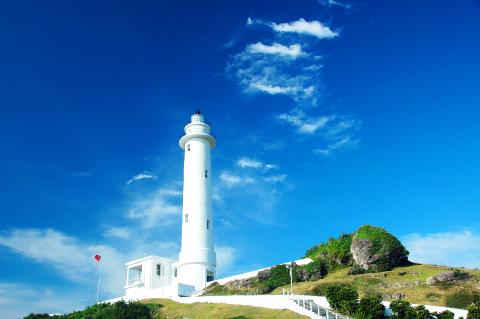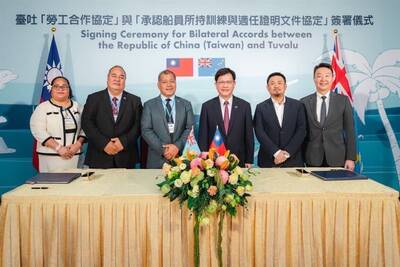Two more lighthouses will be opened to tourists later this year, the Maritime and Port Bureau said yesterday.
The bureau, an agency of the Ministry of Transportation and Communications, took over responsibility for the nation’s lighthouses and navigation aids last month from the Customs Administration, which had been building and managing lighthouses since 1863, first in China and then in Taiwan.
Michael Liang (梁瑞聰), a division director at the bureau, said there are a total of 34 lighthouses, 44 light posts and 14 radar beacons nationwide, including those on Penghu, Kinmen and Matsu.

Photo courtesy of the Maritime and Port Bureau
Only six are open to the public — the ones in Yuwongdao (漁翁島) in Penghu County, Dongjudao (東莒島) and Dongyin Island in Lienchiang County (Matsu), Greater Kaohsiung, Cape San Diego (三貂角) and Oluanpi (鵝鑾鼻).
The bureau is planning to open the Baishachia (白沙岬) Lighthouse in Taoyuan County and Green Island (綠島) Lighthouse to visitors in September, Liang said.
The Baishachia Lighthouse, which has been in operation since 1898, has been designated a historic monument by the Taoyuan County Government, the bureau said, while the Green Island Lighthouse, which went into service in 1939, has been designated a historic building in Taitung County.
Although the functions of a lighthouse have largely been replaced by global positioning systems (GPS), the structures are part of the nation’s cultural heritage and have long histories,such as the one in Yuwongdao (漁翁島), which has been in use since 1778, Liang said. Aside from seeing the old-fashioned lighthouse equipment, visitors to the Yuwongdao site would be able to visit an old graveyard for foreigners nearby, he said.
Nine of the 34 lighthouses have been designated historic buildings or monuments, either by the central government or a city or county government, and five of the nine are open to visitors.
The Wuciou (烏坵) Lighthouse in Kinmen County and Mudouyu (目斗嶼) Lighthouse in Penghu County, both listed historic buildings, are unlikely to be opened for tourists, he said.
“There is no regular boat service to Mudouyu and the Wuciou site is still guarded by the military,” he said.
Earlier this week, Minister of Transportation and Communications Mao Chi-kuo (毛治國) said now that the ministry is responsible for the lighthouses, it would emphasize their tourism value.
The Tourism Bureau said that it would work with the Maritime and Port Bureau to boost the tourism potential of the lighthouses by making lighthouse tours a selling point at festivals and other events organized by its national scenic administrations and other government or non-government organizations.
Tourism Bureau officials cited a travel plan proposed by a participant in last year’s Taiwan Cycling Festival, who visited the northernmost, southernmost, easternmost and westernmost lighthouses in Taiwan proper in just two days by using the railways, the MRT and bicycles.
According to Green Island Township Office, the lighthouse on the island was built after the USS President Hoover ran aground on a reef off the island’s coast on Dec. 11, 1937, while sailing from Japan to the Philippines.
The American Red Cross funded the lighthouse as a thank-you to the islanders who had rescued the passengers and crew of the Hoover.
The lighthouse was destroyed during a World War II air strike and rebuilt by the Chinese Nationalist Party (KMT) government in 1948.
Additional reporting by Staff writer

The Ministry of Economic Affairs has fined Taobao NT$1.2 million (US$36,900) for advertisements that exceeded its approved business scope and ordered the Chinese e-commerce platform to make corrections in the first half of this year or its license would be revoked. Lawmakers have called for stricter supervision of Chinese e-commerce platforms and more stringent measures to prevent China from laundering its goods through Taiwan as US President Donald Trump’s administration cracks down on origin laundering. The legislature’s Finance Committee yesterday met to discuss policies to prevent China from dumping goods in Taiwan, inviting government agencies to report on the matter. Democratic Progressive Party

Taiwan and its Pacific ally Tuvalu on Tuesday signed two accords aimed at facilitating bilateral cooperation on labor affairs, according to Taiwan’s Ministry of Foreign Affairs (MOFA). The governments inked two agreements in Taipei, witnessed by Foreign Minister Lin Chia-lung (林佳龍) and visiting Deputy Tuvaluan Prime Minister Panapasi Nelesone, MOFA said in a news release. According to MOFA, the agreements will facilitate cooperation on labor issues and allow the two sides to mutually recognize seafarers’ certificates and related training. Taiwan would also continue to collaborate with Tuvalu across various fields to promote economic prosperity as well as the well-being of their

The Taipei District Prosecutors’ Office has continued its investigation into allegations of forged signatures in recall efforts today by searching the Chinese Nationalist Party’s (KMT) city chapter and questioning several personnel including the chapter director, according to media reports. Among those questioned and detained were KMT Taipei chapter director Huang Lu Chin-ju (黃呂錦茹), chapter secretary-general Chu Wen-ching (初文卿), chapter secretary Yao Fu-wen (姚富文) and first district committee executive director Tseng Fan-chuan (曾繁川). Prosecutors said they would not confirm reports about who had been summoned. The investigation centers on allegations that the ongoing recall campaigns targeting Democratic Progressive Party legislators Rosalia Wu (吳思瑤)

Several Chinese Nationalist Party (KMT) officials including Chairman Eric Chu (朱立倫) are to be summoned for questioning and then transferred to prosecutors for holding an illegal assembly in Taipei last night, the Taipei Police said today. Chu and two others hosted an illegal assembly and are to be requested to explain their actions, the Taipei City Police Department's Zhongzheng (中正) First Precinct said, referring to a protest held after Huang Lu Chin-ju (黃呂錦茹), KMT Taipei's chapter director, and several other KMT staffers were questioned for alleged signature forgery in recall petitions against Democratic Progressive Party (DPP) legislators. Taipei prosecutors had filed